You should always experiment in your training. By performing experiments you can find out what "works" and what doesn't. This should be an on going process because something that works today may not work a few months from now. However, your experiments should always be performed from a foundation of common sense.
When I first started training I became fixated on the bench press, which is no surprise since many new trainees get fixated on the bench press. The bench press was my first taste of lifting weights. I will never forget the awful feeling of getting crushed under 110 pounds on a Universal bench press machine when I was a freshman in high school. Years later when I competed in powerlifting, I still had a fixation on the bench press.
After all, it was my weakest powerlift and I was determined to increase my poundage. I was willing to experiment, but many times the lure of increasing my bench press clouded my judgement and crumbled the foundation of common sense.
Sets, Repetitions, And Frequency
SETS
How many sets? I found through trial and error that 1-2 work sets were all I needed. I have done bench routines with more than 1-2 work sets, but no benefit was gained with the extra sets and I always became overtrained. This includes the popular pyramid and 5 x 5 routines.
You can work out hard, but not long and hard. Hard and long are mutually exclusive. Adding volume by adding more sets did nothing for me. Quality rules over quantity. As I became more advanced, this became more obvious. Increasing intensity was the way to continued improvement. Adding more sets is not increasing intensity.
REPETITIONS
How many repetitions should you perform? I have experimented with the number of repetitions from singles all the way to 20-rep sets. With a rep count of 8 or above I have never been injured. I have been injured several times using reps of 5 or less. For a long period of time I used exclusively fives or less. This was the period of time in my training when I thought anything above 5 reps was aerobic.
I believe using low reps with heavy weights leaves little margin for error in your technique. I also believe it stresses your nervous system such that overtraining is more likely. The use of low reps does not mean more muscle. In fact, when using low repetitions before a powerlifting contest I have always lost bodyweight without dieting.
I don't believe anyone should be doing less than 5 repetitions for the bench press unless they are a competitive powerlifter getting ready for a contest. Even competitive powerlifters should not have their routine always focused on low reps, unless they want early retirement from powerlifting competition due to injury. I had the tendency to get sloppy with my technique when using 20-rep sets. In general, I recommend a repetition range somewhere between 8 and 15.
Also, the number of repetitions should be cycled. I don't believe one should grind on a specific number of repetitions for weeks on end. After many years of training I find I must change my rep scheme more frequently, about every 3-4 weeks, more for mental reasons than physical.
FREQUENCY
How often should you bench press? I used a two-day-per-week approach when I first started training. It didn't take me long to run into a brick wall. Then I decided to try the heavy/light approach. I found myself working just as hard on the "light" day. The light workout just cut into my recovery. Why bother with a "light" workout? Why not just rest? When I dumped the light workout and switched to benching hard once a week, my bench started climbing again.
I also neglected the toll on my upper body from squatting and deadlifting. I used to bench press without enough time for recovery after a workout where I performed the squat or deadlift. If your upper-body muscles are still fatigued from squatting or deadlifting, it is pretty hard to make gains in the bench press. If you are working your body in an upper/lower split, rest at least 72 hours between these workouts. The muscles used in the bench press do get hit to a degree when squatting and deadlifting. I neglected this fact in my recovery, don't you.
Technique
Wide grip? Close grip? High on chest? Low on chest? Pause, or touch and go? Fast or slow? Arch or no arch? Just thinking about all the things I tried to increase my bench press makes me dizzy.
GRIP WIDTH
I was constantly experimenting with my grip width to maximize my bench press poundage. The maximum allowable grip width for powerlifting is 32 inches (81 cm) between the index fingers. The wide grip decreases the distance you have to press the bar, but are you really any stronger if you can press more with a wide grip? I was often changing my grip around the 32-inch mark.
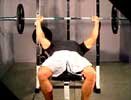 Wide Grip |
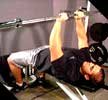 Close Grip |
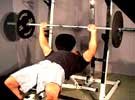 Perfect Grip |
For me, 32 inches is a wide grip. The Wide Grip Bench Press will wreck most people's shoulders. I believe using a wide grip contributed to several of my injuries. Today, I use a grip that minimizes injury potential. My grip width is now about 24 inches. I would not recommend going much wider than shoulder width on your bench press grip. Experiment around this range to find the grip width most suitable to you.
BAR PLACEMENT
I experimented with bar placement almost as much as grip width, to increase my bench press. This included doing bench presses to the neck to "hit my upper pecs." Unless you have a death wish and want to wreck your shoulders, don't do bench presses to your neck. Bench presses to my neck did nothing but give me sore shoulders. The same result occurred for bench presses to my upper chest. I found that my "sweet spot" for bar placement was simply an imaginary line drawn along the lowest points of my pec muscles.
METHOD
For many years I did my bench press repetitions with a touch and go. Because I was competing in powerlifting and the rules required a pause, I did practice the pause at the chest just before a contest. Because I developed some shoulder injuries, I decided to experiment and pause every rep. Since switching to a pause on each rep, I haven't had any shoulder injuries.
How long do you pause? You should pause long enough so the bar comes to a complete, motionless stop at the chest. There is less chance of injury due to the reduction in the change in force on the body when moving from the negative to positive portion of the rep. Pausing also reduces the chance of getting out of the "groove." If you get out of the groove you are more likely to injure yourself.
SPEED AND PACE
Your bench press repetitions should be under control-period. If you aren't under control, you will get injured. When I first started lifting, you might have heard the word "explode" called out by my training partner when I was performing the bench press. After a few near pec tears because I got out of the groove while "exploding," I now recommend a smooth deliberate rep.
What speed do I use? To be honest I don't count. I believe it is the acceleration caused by "exploding" repetitions that contributes to injuries. There is nothing magic about the speed I use, but a key point is that I try and maintain a constant rate on the bar throughout the repetition.
THE BACK ARCH
Many trainees, especially powerlifters, use a back arch to decrease the distance the bar is pressed. Unfortunately, as a powerlifter I experimented with various ways to increase my arch to decrease the distance the bar had to be pressed. I would really drive with my legs with my back arched. This was pretty stupid. If I was to do it all over again, I would not arch, not even in competition. The danger to the low back is just too great. Chronic lower back pain or worse can be the result. Don't arch. Keep your back flat on the bench.
Bench Press Gadgets
I have experimented with a couple of bench press gadgets. In retrospect, these gadgets were down right dangerous and I am lucky I wasn't seriously injured. Gadgets should be left to James Bond and not weight trainees. There are no magical gadgets for increasing the poundage of your bench press, or any other lift for that matter.
The newest training gadget is called a Swiss ball. This is basically a very large pliable ball. Some trainers are advocating doing pressing movements (and even squats-no kidding!) on top of this unstable ball. I can't help but think The Ringling Brothers and Barnum and Bailey Circus are paying some of these trainers to recruit future performers! Now for my gadget experiments.
WEIGHT RELEASES
A weight release is a plyometric device that is a metal hook with a plate at the bottom to hold weights. The weight releases are then hooked over the ends of the bar. When the bar hits the chest, the weight releases hit the ground causing the hooks, and thus the weights on the weight releases, to disengage from the bar. This enables the lifter to perform an overload for the negative portion of the repetition.
For example, a lifter with 225 pounds on the bar could use 25 pounds on each weight release which then adds up to a total of 275 pounds on the bar. When the lifter gets the bar to his chest, the weight releases disengage and 225 lbs is left on the bar for the positive part of the rep.
The weight releases were awkward. The bar was hard to control and it was hard to get both of the weight releases to disengage at the same time. The release of the weights on the ends of the bar results in a dangerous change in force on the body at the bottom of the rep. This an outcome typical of plyometrics. It took only a few times using these devices to turn them into dust collectors in my home gym.
CAMBERED BENCH PRESS BAR 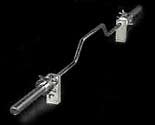 When I saw that a multiple world recorder holder in the bench press use a cambered bench press bar, I thought it might be the "secret" to increasing my bench press. The cambered bench press bar is a regular Olympic bar with a bend in the middle so the lifter can lower his hands (and the resistance) to a level below his chest. This bar puts a tremendous stretch on the shoulders. I now call this bar "the shoulder wrecker."
When I saw that a multiple world recorder holder in the bench press use a cambered bench press bar, I thought it might be the "secret" to increasing my bench press. The cambered bench press bar is a regular Olympic bar with a bend in the middle so the lifter can lower his hands (and the resistance) to a level below his chest. This bar puts a tremendous stretch on the shoulders. I now call this bar "the shoulder wrecker."
Don't ever use one. I almost permanently wrecked my shoulders with this bar and it didn't magically increase my bench press.
Bench Press Assistance Exercises
In powerlifting, upper-body exercises for the chest, shoulders and triceps other than the bench press are generally referred to as "assistance exercises." I have experimented with many assistance exercises. Many lifters overdo the use of these exercises. I was no different, and it often resulted in overtraining. The following are my results with some of the more popular assistance exercises for the bench press.
LYING TRICEP EXTENSIONS 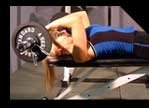 Lying Triceps Extensions or "skull crushers" did nothing for me but make my elbows sore. When the weight started to get heavy, my elbows started to hurt. This exercise will wreck your elbows. Forget this exercise. Besides, I like training to failure and a knurl pattern stamped on my forehead wouldn't be an attractive addition to my facial features.
Lying Triceps Extensions or "skull crushers" did nothing for me but make my elbows sore. When the weight started to get heavy, my elbows started to hurt. This exercise will wreck your elbows. Forget this exercise. Besides, I like training to failure and a knurl pattern stamped on my forehead wouldn't be an attractive addition to my facial features.
TRICEP PUSHDOWNS  Tricep Pushdowns competed with skull crushers for last place on my list of effective assistance exercises. I could never use enough weight to provide any benefit. When I tried to use more weight, I ended up doing a weird standing form of a close grip bench press. I often got funny looks from people because there was grease from the cable on the side of my face. The only tricep exercise more useless is the tricep kickback. Pushdowns, 20 sets for arms, and the "da pump" all belong in the same category ... bunk.
Tricep Pushdowns competed with skull crushers for last place on my list of effective assistance exercises. I could never use enough weight to provide any benefit. When I tried to use more weight, I ended up doing a weird standing form of a close grip bench press. I often got funny looks from people because there was grease from the cable on the side of my face. The only tricep exercise more useless is the tricep kickback. Pushdowns, 20 sets for arms, and the "da pump" all belong in the same category ... bunk.
CLOSE-GRIP BENCH PRESS 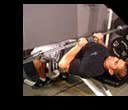 When I first experimented with the Close-Grip Bench Press I thought the grip had to be about 6-10 inches apart. This hurt my wrists and elbows. I learned that "close" should mean "closer" than your normal grip, but not actually "close." I found when my close-grip bench poundage was increasing, so did my normal-grip bench press.
When I first experimented with the Close-Grip Bench Press I thought the grip had to be about 6-10 inches apart. This hurt my wrists and elbows. I learned that "close" should mean "closer" than your normal grip, but not actually "close." I found when my close-grip bench poundage was increasing, so did my normal-grip bench press.
This exercise has been a mainstay in my routine and will continue to be until the last shovel full is thrown on top. In my early years of training, I did too many sets. Today, when I do the close-grip bench press, I do one all-out set. I use the same repetition range as the regular bench press.
SHOULDER PRESS
 The Shoulder Press is also a keeper. Besides close-grip bench presses, the shoulder press has withstood the test of time with me. I have experimented with various forms and grip widths. I tried the press behind the neck because, you guessed it, Joe Bench Press Champion said he used it to help his bench press. I dropped it because it did not feel natural to me and I felt it exposed my shoulders to injury. I found that I liked the Dumbbell Press rather than a Barbell Press for shoulder presses.
The Shoulder Press is also a keeper. Besides close-grip bench presses, the shoulder press has withstood the test of time with me. I have experimented with various forms and grip widths. I tried the press behind the neck because, you guessed it, Joe Bench Press Champion said he used it to help his bench press. I dropped it because it did not feel natural to me and I felt it exposed my shoulders to injury. I found that I liked the Dumbbell Press rather than a Barbell Press for shoulder presses.
A wide grip on any form of shoulder press bothered my shoulders. Pressing with a wide grip does not make your shoulders wider.
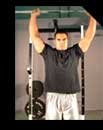 I also found that I liked using a grip with my palms facing my body. You don't see too many people using this grip. This position feels more natural to me than the palms facing forward pronated grip. I never liked Standing Presses because I felt they stressed my low back too much. I do my dumbbell shoulder presses on an incline bench with a just a slight angle back from vertical on the upright pad. I use the same repetition range as the bench press.
I also found that I liked using a grip with my palms facing my body. You don't see too many people using this grip. This position feels more natural to me than the palms facing forward pronated grip. I never liked Standing Presses because I felt they stressed my low back too much. I do my dumbbell shoulder presses on an incline bench with a just a slight angle back from vertical on the upright pad. I use the same repetition range as the bench press.
The Final Word
In my bench press experiments in the gym, good sense and the basics won out.
To summarize:
- Do no more than 1-2 work sets.
- Use a rep range of 8-15 and don't get stuck in one rep pattern.
- Don't bench press more than once every 7 days.
- Don't use a wide grip-your maximum grip should not be much wider than shoulder-width apart.
- The bar should touch the highest point on your chest.
- Pause at the chest on each repetition.
- Keep the bar under control and push at constant rate.
- Don't arch your back.
- Forget about gadgets to increase your bench press.
- Forget about exercises such as skull crushers and tricep pushdowns.
- The shoulder press and close-grip bench press may be effective additions to your program for increasing your bench press.
Don't get fixated on the bench press. It can be a productive exercise if used wisely. The majority of muscle I have today is not the result of bench pressing. The squat and deadlift should never take a back seat to the bench press.
